2009 PORSCHE PANAMERA steering
[x] Cancel search: steeringPage 55 of 343
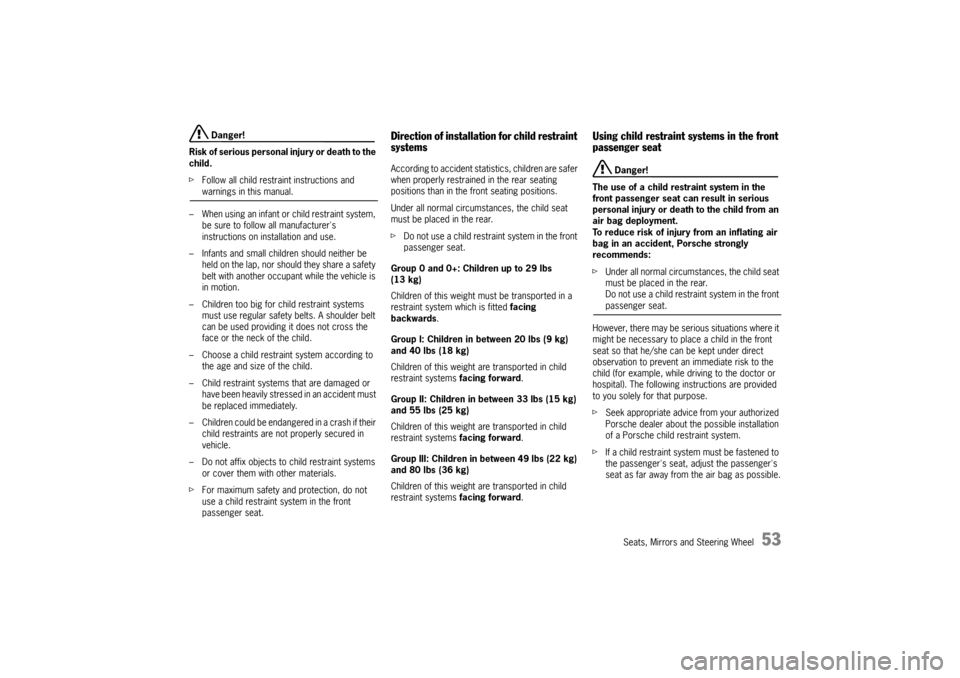
Seats, Mirrors and Steering Wheel
53
Danger!
Risk of serious personal injury or death to the
child.
f Follow all child restraint instructions and warnings in this manual.
– When using an infant or child restraint system, be sure to follow all manufacturer's
instructions on installation and use.
– Infants and small children should neither be held on the lap, nor should they share a safety
belt with another occupant while the vehicle is
in motion.
– Children too big for child restraint systems must use regular safety belts. A shoulder belt
can be used providing it does not cross the
face or the neck of the child.
– Choose a child restraint system according to the age and size of the child.
– Child restraint systems that are damaged or have been heavily stressed in an accident must
be replaced immediately.
– Children could be endangered in a crash if their child restraints are not properly secured in
vehicle.
– Do not affix objects to child restraint systems or cover them with other materials.
f For maximum safety and protection, do not
use a child restraint system in the front
passenger seat.
Direction of installation for child restraint
systemsAccording to accident statistics, children are safer
when properly restrained in the rear seating
positions than in the front seating positions.
Under all normal circumstances, the child seat
must be placed in the rear.
fDo not use a child restraint system in the front
passenger seat.
Group 0 and 0+: Children up to 29 lbs
(13 kg)
Children of this weight must be transported in a
restraint system which is fitted facing
backwards .
Group I: Children in between 20 lbs (9 kg)
and 40 lbs (18 kg)
Children of this weight are transported in child
restraint systems facing forward.
Group II: Children in between 33 lbs (15 kg)
and 55 lbs (25 kg)
Children of this weight are transported in child
restraint systems facing forward.
Group III: Children in between 49 lbs (22 kg)
and 80 lbs (36 kg)
Children of this weight are transported in child
restraint systems facing forward.
Using child restraint systems in the front
passenger seat
Danger!
The use of a child restraint system in the
front passenger seat can result in serious
personal injury or death to the child from an
air bag deployment.
To reduce risk of injury from an inflating air
bag in an accident, Porsche strongly
recommends:
f Under all normal circumstances, the child seat
must be placed in the rear.
Do not use a child restrai nt system in the front passenger seat.
However, there may be se rious situations where it
might be necessary to pl ace a child in the front
seat so that he/she can be kept under direct
observation to prevent an immediate risk to the
child (for example, while driving to the doctor or
hospital). The following in structions are provided
to you solely for that purpose.
f Seek appropriate advice from your authorized
Porsche dealer about the possible installation
of a Porsche child restraint system.
f If a child restraint system must be fastened to
the passenger's seat, adjust the passenger's
seat as far away from the air bag as possible.
Page 56 of 343
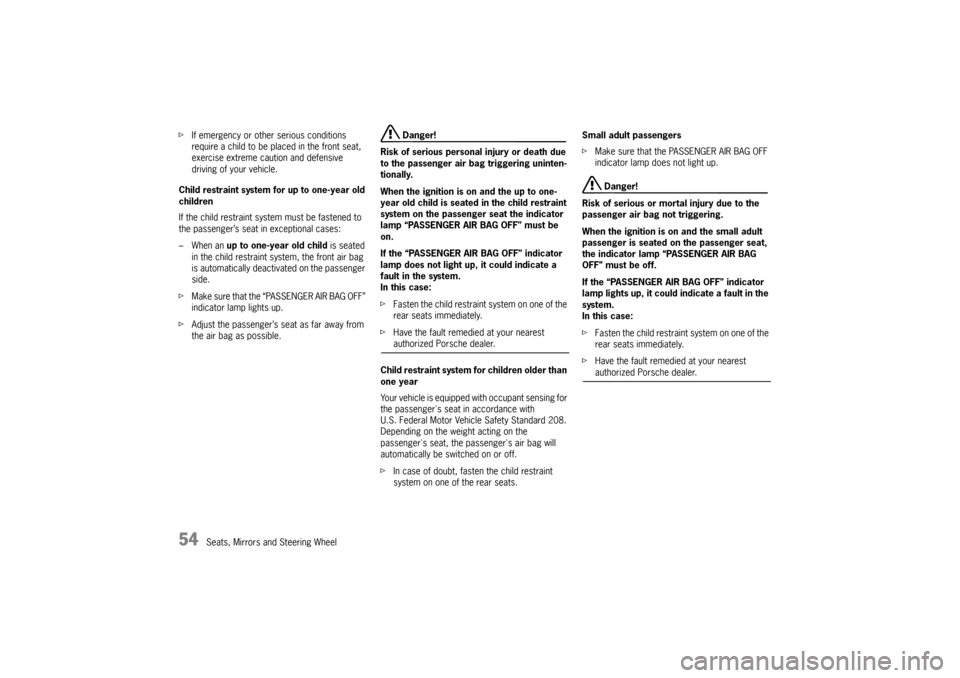
54
Seats, Mirrors and Steering Wheel
f
If emergency or other serious conditions
require a child to be pl aced in the front seat,
exercise extreme caution and defensive
driving of your vehicle.
Child restraint system for up to one-year old
children
If the child restraint syst em must be fastened to
the passenger’s seat in exceptional cases:
– When an up to one-year old child is seated
in the child restraint system, the front air bag
is automatically deacti vated on the passenger
side.
f Make sure that the “PASSENGER AIR BAG OFF”
indicator lamp lights up.
f Adjust the passenger’s seat as far away from
the air bag as possible.
Danger!
Risk of serious personal injury or death due
to the passenger air bag triggering uninten-
tionally.
When the ignition is on and the up to one-
year old child is seated in the child restraint
system on the passenger seat the indicator
lamp “PASSENGER AIR BAG OFF” must be
on.
If the “PASSENGER AIR BAG OFF” indicator
lamp does not light up, it could indicate a
fault in the system.
In this case:
f Fasten the child restraint system on one of the
rear seats immediately.
f Have the fault remedied at your nearest authorized Porsche dealer.
Child restraint system for children older than
one year
Your vehicle is equipped with occupant sensing for
the passenger's seat in accordance with
U.S. Federal Motor Vehicle Safety Standard 208.
Depending on the weight acting on the
passenger's seat, the passenger's air bag will
automatically be switched on or off.
f In case of doubt, fasten the child restraint
system on one of the rear seats. Small adult passengers
f
Make sure that the PASSENGER AIR BAG OFF
indicator lamp does not light up.
Danger!
Risk of serious or mortal injury due to the
passenger air bag not triggering.
When the ignition is on and the small adult
passenger is seated on the passenger seat,
the indicator lamp “PASSENGER AIR BAG
OFF” must be off.
If the “PASSENGER AIR BAG OFF” indicator
lamp lights up, it could indicate a fault in the
system.
In this case:
f Fasten the child restraint system on one of the
rear seats immediately.
f Have the fault remedied at your nearest authorized Porsche dealer.
Page 57 of 343
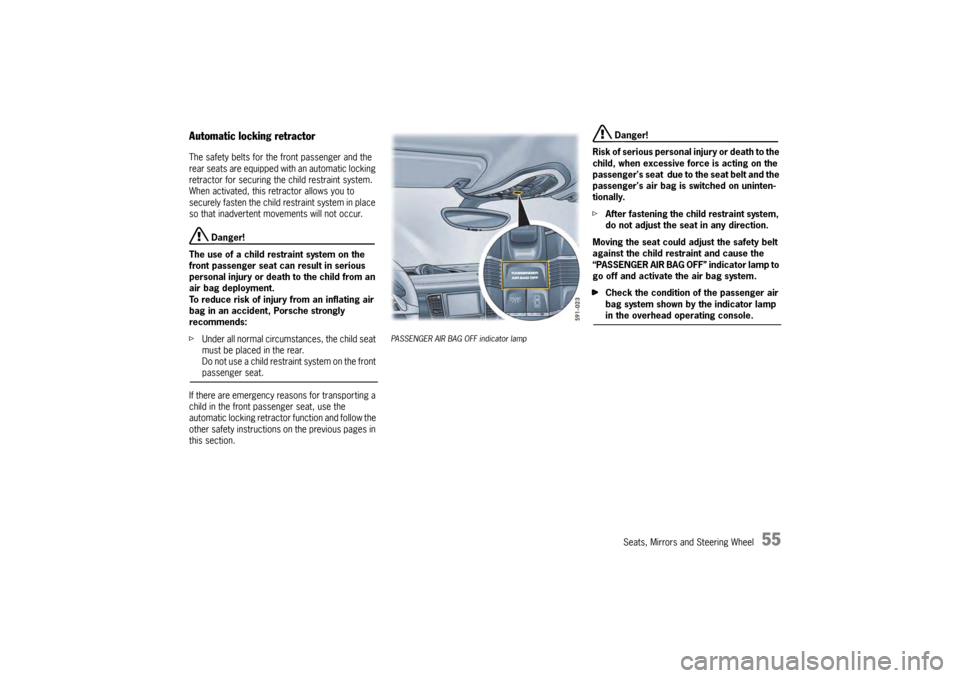
Seats, Mirrors and Steering Wheel
55
Automatic locking retractorThe safety belts for the front passenger and the
rear seats are equipped with an automatic locking
retractor for securing the child restraint system.
When activated, this retractor allows you to
securely fasten the child restraint system in place
so that inadvertent movements will not occur.
Danger!
The use of a child restraint system on the
front passenger seat can result in serious
personal injury or death to the child from an
air bag deployment.
To reduce risk of injury from an inflating air
bag in an accident, Porsche strongly
recommends:
f Under all normal circumstances, the child seat
must be placed in the rear.
Do not use a child restraint system on the front passenger seat.
If there are emergency reasons for transporting a
child in the front pa ssenger seat, use the
automatic locking retracto r function and follow the
other safety instructions on the previous pages in
this section.
PASSENGER AIR BAG OFF indicator lamp
Danger!
Risk of serious personal injury or death to the
child, when excessive force is acting on the
passenger's seat due to the seat belt and the
passenger's air bag is switched on uninten-
tionally.
f After fastening the child restraint system,
do not adjust the seat in any direction.
Moving the seat could adjust the safety belt
against the child restraint and cause the
“PASSENGER AIR BAG OFF” indicator lamp to
go off and activate the air bag system.
f Check the condition of the passenger air
bag system shown by the indicator lamp in the overhead operating console.
Page 58 of 343
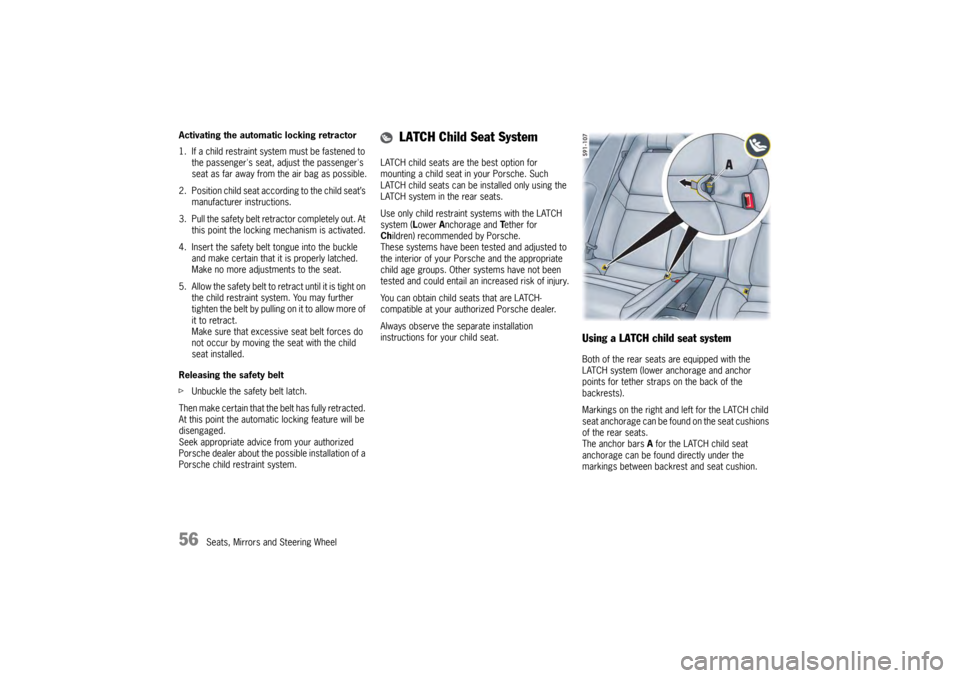
56
Seats, Mirrors and Steering Wheel
Activating the automa
tic locking retractor
1. If a child restraint syst em must be fastened to
the passenger's seat, adjust the passenger's
seat as far away from the air bag as possible.
2. Position child seat according to the child seat’s manufacturer instructions.
3. Pull the safety belt retr actor completely out. At
this point the locking mechanism is activated.
4. Insert the safety belt tongue into the buckle and make certain that it is properly latched.
Make no more adjustments to the seat.
5. Allow the safety belt to retract until it is tight on the child restraint system. You may further
tighten the belt by pulling o n i t t o a l l o w m o re o f
it to retract.
Make sure that excessive seat belt forces do
not occur by moving the seat with the child
seat installed.
Releasing the safety belt
f Unbuckle the safety belt latch.
Then make certain that the belt has fully retracted.
At this point the automati c locking feature will be
disengaged.
Seek appropriate advice from your authorized
Porsche dealer about the possible installation of a
Porsche child restraint system. LATCH child seats are the best option for
mounting a child seat in your Porsche. Such
LATCH child seats can be
installed only using the
LATCH system in the rear seats.
Use only child restraint systems with the LATCH
system ( Lower A nchorage and Tether for
Ch ildren) recommended by Porsche.
These systems have been tested and adjusted to
the interior of your Po rsche and the appropriate
child age groups. Other systems have not been
tested and could entail an increased risk of injury.
You can obtain child seats that are LATCH-
compatible at your authorized Porsche dealer.
Always observe the separate installation
instructions for your child seat.
Using a LATCH child seat systemBoth of the rear seats are equipped with the
LATCH system (lower anchorage and anchor
points for tether straps on the back of the
backrests).
Markings on the right and left for the LATCH child
seat anchorage can be found on the seat cushions
of the rear seats.
The anchor bars A for the LATCH child seat
anchorage can be found directly under the
markings between backrest and seat cushion.
LATCH Child Seat System
Page 59 of 343
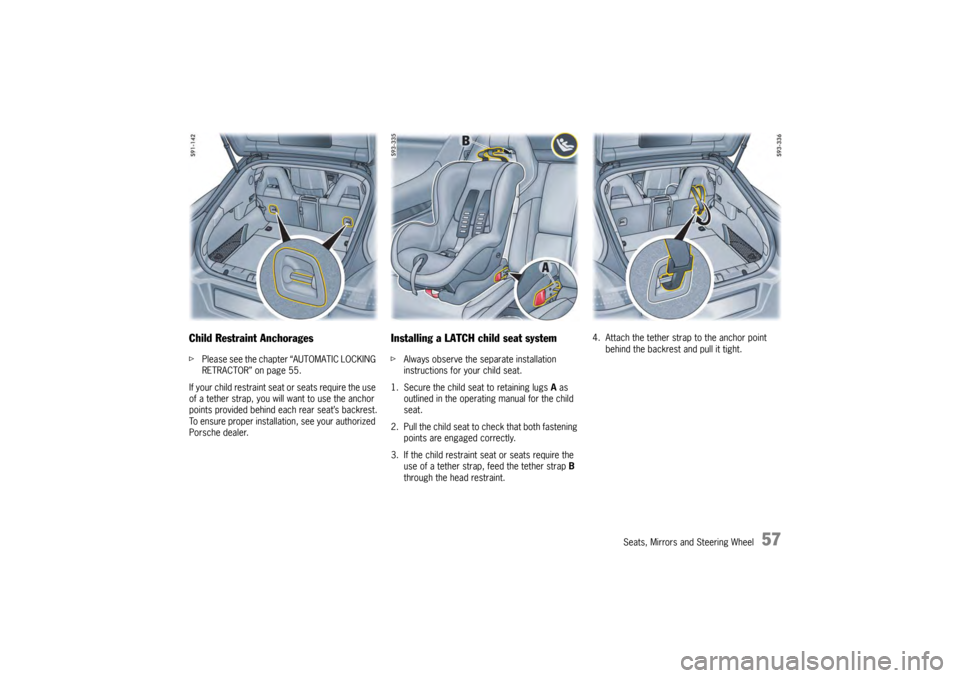
Seats, Mirrors and Steering Wheel
57
Child Restraint AnchoragesfPlease see the chapter “AUTOMATIC LOCKING
RETRACTOR” on page 55.
If your child restraint seat or seats require the use
of a tether strap, you will want to use the anchor
points provided behind each rear seat’s backrest.
To ensure proper installation, see your authorized
Porsche dealer.
Installing a LATCH child seat systemf Always observe the separate installation
instructions for your child seat.
1. Secure the child seat to retaining lugs A as
outlined in the operating manual for the child
seat.
2. Pull the child seat to check that both fastening points are engaged correctly.
3. If the child restraint seat or seats require the use of a tether strap, feed the tether strap B
through the head restraint. 4. Attach the tether strap to the anchor point
behind the backrest and pull it tight.
Page 60 of 343
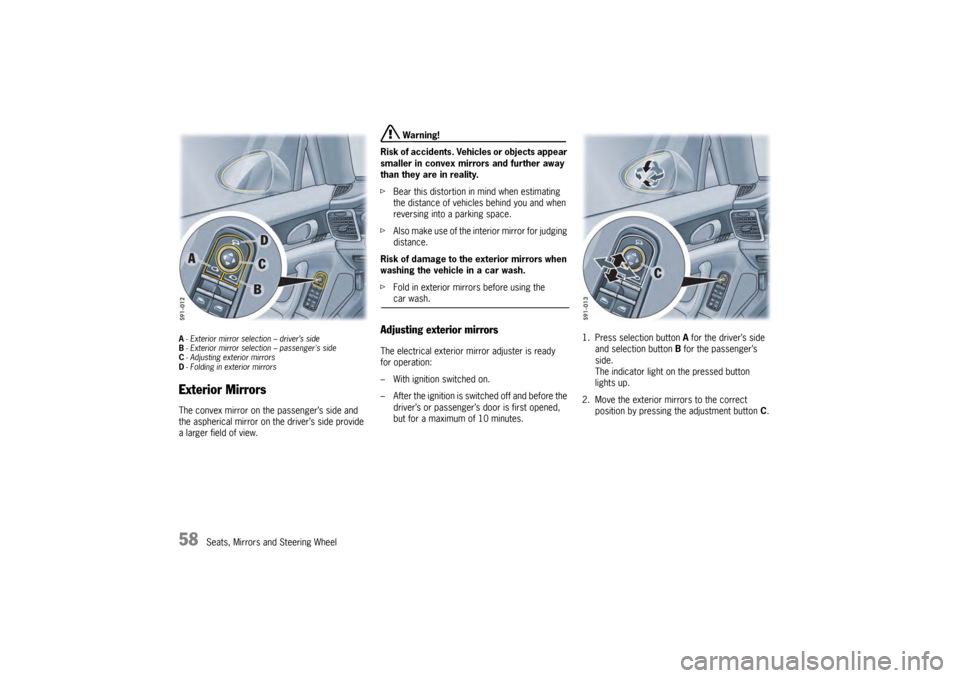
58
Seats, Mirrors and Steering Wheel
A- Exterior mirror selection – driver’s side
B - Exterior mirror selection – passenger's side
C - Adjusting exterior mirrors
D - Folding in exterior mirrorsExterior MirrorsThe convex mirror on the passenger’s side and
the aspherical mirror on the driver’s side provide
a larger field of view.
Warning!
Risk of accidents. Vehi cles or objects appear
smaller in convex mirrors and further away
than they are in reality.
f Bear this distortion in mind when estimating
the distance of vehicles behind you and when
reversing into a parking space.
f Also make use of the interior mirror for judging
distance.
Risk of damage to the exterior mirrors when
washing the vehicle in a car wash.
f Fold in exterior mirrors before using the car wash.
Adjusting exterior mirrors The electrical exterior mirror adjuster is ready
for operation:
– With ignition switched on.
– After the ignition is switched off and before the
driver’s or passenger’s door is first opened,
but for a maximum of 10 minutes. 1. Press selection button
A for the driver’s side
and selection button B for the passenger’s
side.
The indicator light on the pressed button
lights up.
2. Move the exterior mirrors to the correct position by pressing the adjustment button C.
Page 61 of 343
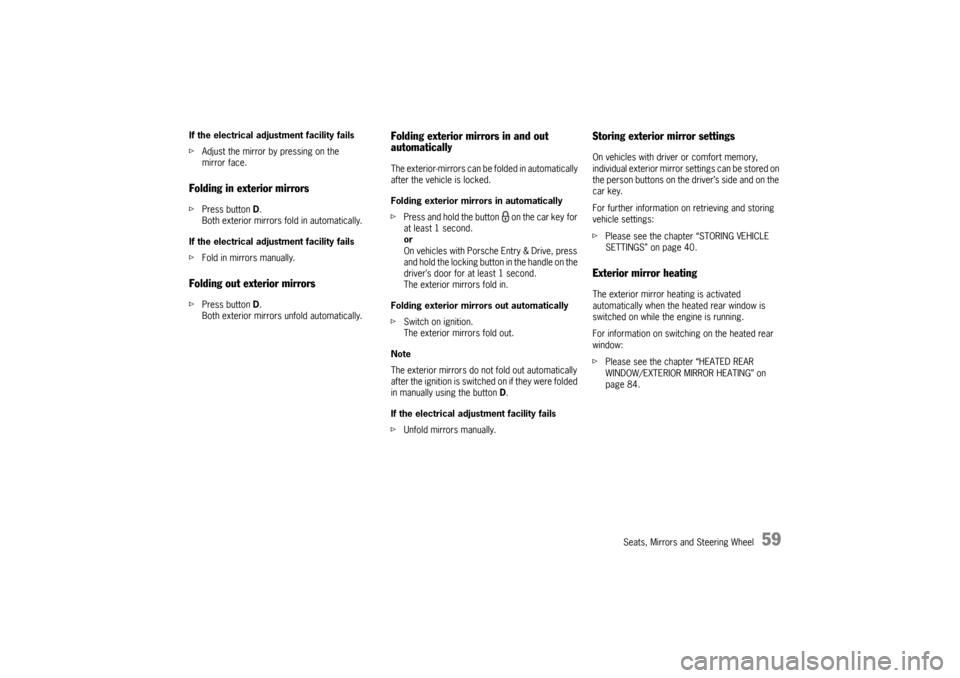
Seats, Mirrors and Steering Wheel
59
If the electrical adjustment facility fails
f Adjust the mirror by pressing on the
mirror face.Folding in exterior mirrorsfPress button D.
Both exterior mirrors fold in automatically.
If the electrical adjustment facility fails
f Fold in mirrors manually.Folding out exterior mirrorsfPress button D.
Both exterior mirrors unfold automatically.
Folding exterior mirrors in and out
automaticallyThe exterior-mirrors can be folded in automatically
after the vehicle is locked.
Folding exterior mirrors in automatically
f Press and hold the button on the car key for
at least 1 second.
or
On vehicles with Porsche Entry & Drive, press
and hold the locking button in the handle on the
driver’s door for at least 1 second.
The exterior mirrors fold in.
Folding exterior mirr ors out automatically
f Switch on ignition.
The exterior mirrors fold out.
Note
The exterior mirrors do not fold out automatically
after the ignition is switch ed on if they were folded
in manually using the button D.
If the electrical adj ustment facility fails
f Unfold mirrors manually.
Storing exterior mirror settingsOn vehicles with driver or comfort memory,
individual exterior mirror settings can be stored on
the person buttons on the driver’s side and on the
car key.
For further information on retrieving and storing
vehicle settings:
f Please see the chapter “STORING VEHICLE
SETTINGS” on page 40.Exterior mirror heatingThe exterior mirror heating is activated
automatically when the heated rear window is
switched on while the engine is running.
For information on switch ing on the heated rear
window:
f Please see the chapter “HEATED REAR
WINDOW/EXTERIOR MIRROR HEATING” on
page 84.
Page 62 of 343

60
Seats, Mirrors and Steering Wheel
Automatic anti-dazzle exterior mirrorThe exterior mirrors change to anti-dazzle
position automatically in synchronisation with
the interior mirror.
For information on the automatic anti-dazzle
function of the interior mirror:
fPlease see the chapter “AUTOMATIC ANTI-
DAZZLE INTERIOR MIRROR” on page 60.Swivelling down mirror glass as
parking aid When reverse gear is engaged, the mirror on the
passenger’s side swivels down slightly to show
the curb area.
f Please see the chapter “SWIVELLING DOWN
MIRROR GLASS AS PARKING AID” on
page 242.
Automatic anti-dazzle interior mirrorSensors on the front and rear sides of the interior
mirror measure the incident light. The mirrors
automatically change to anti-dazzle position or
revert to their normal state, depending on the light
intensity.
Note on operation
The incidental light within the detection area
of the light sensor C must not be restricted
(e.g. by stickers on the rear window or items
of luggage in the luggage compartment). Switching off automatic anti-dazzle function
f
Press button B.
The indicator light A goes out.
Note on operation
The anti-dazzle function switches off
automatically if:
– Reverse gear is engaged or
– Interior lighting is switched on.
Switching on automatic anti-dazzle function
f Press button B.
Indicator light A lights up.
Warning!
Risk of injury. Electrolyte fluid may escape
from broken mirror glass. This fluid irritates
the skin and eyes.
f If the electrolyte fluid sh ould come into contact
with the skin or eyes, rinse it off immediately
with clean water.
Seek medical attention if necessary.
Risk of damage to paintwork, leather, plastic
parts and clothing. Electrolyte fluid can be
removed only while it is still wet.
f Clean the affected parts with water.